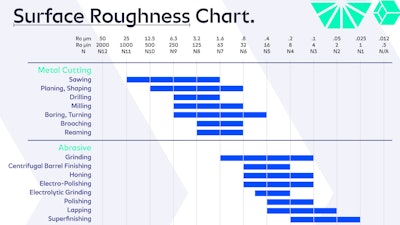In precision engineering, the term “surface roughness” may appear deceptively simple, but its impact on the performance, durability and aesthetics of engineering components cannot be overstated. Whether a fastener, screw or bolt is destined for use in aerospace, automotive, medical or consumer electronics, surface roughness plays a critical role in how that part performs over its lifecycle.
What is surface roughness?
The term Surface Roughness refers to the small, often microscopic deviations or irregularities that occur on the surface of a material, which is typically due to machining, casting, or finishing processes. These irregularities can vary from fine, closely spaced peaks and valleys to larger, more pronounced undulations.
Surface roughness, however, is not simply a cosmetic issue; it is a fundamental property that affects how components interact and perform in real-world applications. For manufacturers, the challenge lies in achieving the right balance of roughness for each application. The wrong surface texture can lead to inefficiencies, premature wear and even system failure. On the other hand, a carefully controlled roughness profile can enhance performance, increase the lifespan of components and contribute to the overall reliability of the final product.
One of the most significant impacts of surface roughness is its effect on performance. In mechanical systems, components often interact through sliding, rotating or pressing motions. The roughness of a part’s surface directly influences friction and wear—two key factors in determining the efficiency and longevity of the system.
Friction is an important consideration. Smoother surfaces typically result in less friction, which is critical in applications like bearings, gears and seals, where reduced resistance is needed for smooth operation. In contrast, higher roughness can increase friction, leading to inefficiencies and heat generation. For example, an engine part with a rough surface and higher friction increases the energy needed to perform a task, leading to higher wear and potential failure.
Wear resistance is another critical aspect of surface roughness. Surfaces that are too rough are more susceptible to abrasive wear, leading to premature failure, while a smoother surface generally improves a component’s ability to resist wear and fatigue.
This explains why surface roughness is particularly important in high-performance environments, like aerospace or automotive sectors, where components are subjected to repeated stress and need to perform reliably over long periods.
 Part of Accu’s surface roughness chart.Accu
Part of Accu’s surface roughness chart.Accu
Durability and fatigue strength
Durability is another key concern. The smoother the surface, the less likely it is to develop cracks under stress. Fatigue strength, which refers to a material’s ability to withstand repeated cycles of stress without failing, is affected by surface irregularities. Surface roughness creates stress concentrators that can accelerate crack initiation, reducing the lifespan of a component under cyclic loading.
In aerospace applications, for example, where parts are subject to constant vibration and stress, any irregularities on a surface can serve as focal points for fatigue failure. In contrast, parts with well-controlled surface roughness can withstand repeated stresses and extend service life, even in extreme conditions.
Aesthetics and consumer perception
Surface roughness is often associated with the aesthetic quality of a component. Whether it’s a consumer electronics housing or a medical device, the look and feel of a product can greatly influence customer perception and satisfaction. A surface that is too rough or has visible marks from the manufacturing process can signal poor quality, while a smooth, polished surface displays precision and attention to detail.
Lubrication and friction management
The lubrication properties of a fastener are also influenced by its surface roughness. Surfaces that are too smooth may not retain enough lubricant, while surfaces that are too rough might hold excess lubricant, which can lead to unwanted friction or contamination. A finely tuned roughness profile will ensure that lubricants are evenly distributed and stay in place, optimizing performance and extending component life.
In applications like hydraulic systems or engines, maintaining the right surface roughness ensures that parts interact with lubricants in a way that minimizes friction and wear while maintaining proper lubrication flow.
Impact on industries
Surface roughness impacts a wide range of industries, particularly those where precision and reliability are paramount. In aerospace, smooth surfaces on aircraft parts reduce drag, improving fuel efficiency. In addition, reducing surface irregularities can prevent premature failure under high-stress conditions.
 Drill and milling bits.Accu
Drill and milling bits.Accu
In automotive components, surface finish influences everything from engine performance to the comfort of the driver. Parts like pistons, valve lifters and bearings benefit from controlled surface roughness, which improves efficiency and reduces friction. The aesthetic appeal of automotive parts, such as trim and body panels, is also critical for consumer satisfaction.
In the medical sector, surface roughness affects both the functionality and safety of devices. For implants, fine control of surface finish is necessary to ensure the components are suitable for use, for example, smooth finishes on gliding surfaces in a knee replacement, or uniform rough texture on implants intended for osseointegration. Surgical instruments also rely on precise surface finishes to ensure accuracy and durability, as well as to reduce nucleation points for contaminants to reduce the risk of infection.
The performance of electronic components, such as connectors and enclosures, is also heavily influenced by surface roughness. A smooth, precise surface ensures that parts fit together well, reducing the risk of electrical failure and enhancing the efficiency of heat dissipation.
Surface roughness in manufacturing is a critical part of determining a component’s performance. By understanding the relationship between surface texture and component function, manufacturers can increase the lifespan of components and enhance their operational performance across various industries.
Whether an engineer is working with fasteners for engineering, stainless steel screws or nuts and bolts, controlling surface roughness is essential for achieving optimal results and meeting both technical and customer expectations.
Patrick Faulkner is the Lead Engineer at Accu, a supplier of precision engineering components.

